Is there a way to test to see what your THC levels are
Announcement
Collapse
No announcement yet.
What is your biggest question about growing cannabis?
Collapse
This is a sticky topic.
X
X
-
-
Yes, there is cannabinoid testing. You can either do it on buds after they're already grown, or you can perform a leaf test on young plants to get a rough idea of what cannabinoid ratios to expect later on. Here's one company that performs basic tests for about $40 (with more expensive options if you want to test for other cannabinoids, terpenes, etc): http://www.sdpharmlabs.com/pages/about-us I've never used them myself, but I've spoken with growers who have used them and were happy with the results of testing.
-
-
Is there an Optimal Final Height for the plant?
Most everything I read says to continue the Vegatative stage until the plant is about 1/2 its desired height, then flip to Flowering stage.
Assuming you are keeping the canopy as flat as possible. Should you try for as tall as your tent/light will allow without burn? or is there an optimal height found to give best yield/quality? Does the plant waste energy moving the nutrients up a taller plant?
I see amazing pictures here of bountiful plants that appear to be under 36", with lots of fat dense colas.
Thanks.
- Likes 1
Comment
-
That's an interesting question! I'm definitely not an expert in this and I'd love to see other opinions, but this is what seems to be true for me when growing indoors.Originally posted by drbabe View PostIs there an Optimal Final Height for the plant?
Most everything I read says to continue the Vegatative stage until the plant is about 1/2 its desired height, then flip to Flowering stage.
Assuming you are keeping the canopy as flat as possible. Should you try for as tall as your tent/light will allow without burn? or is there an optimal height found to give best yield/quality? Does the plant waste energy moving the nutrients up a taller plant?
I see amazing pictures here of bountiful plants that appear to be under 36", with lots of fat dense colas.
Thanks.
When it comes to training, in the best case scenario you want to get long colas that are as long as your light penetration. However, there's no point in having buds that are located below where they get light, because they will not fatten up. So indoors the optimal length of buds is dependent on your grow light.
Let's say I have a 250W HPS grow light. The longest cola I was ever able to get from that light was about 12" long. There never seems to be significant buds below the 12" mark with the 250W. So I want about 12" of "stretch" on those colas after the switch to 12/12. So I personally feel like switching the plant to 12/12 when it's about 12" tall ends up giving you colas that are 12" long. However, if I let the plant grow to 2 feet first, I'd end up with 2 feet worth of colas being added to the plant, but they would only fatten up down to about 12", and all that lower growth that was made in the vegetative stage would have been wasted time.
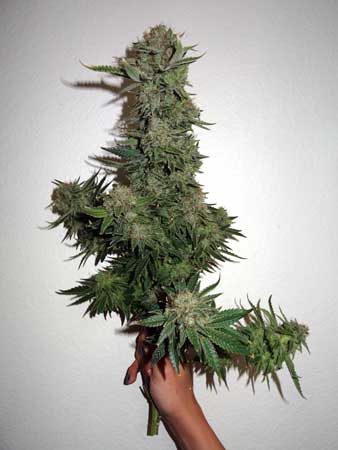
Under a 600W HPS, I haven't ever seen a cola really thicken for longer than 2 feet even if light is getting down almost to the floor. So I'm not sure how much benefit you would get by switching to 12/12 after the plant is 2 feet tall. These plants were switched at around 20".
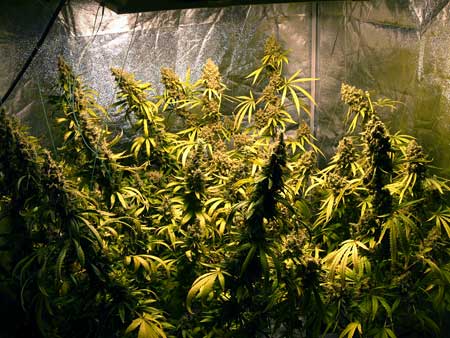
You can support even taller plants and longer colas under a 1000W light.
These restrictions don't seem to apply as much to outdoor plants. It seems like outdoors, plants will keep getting taller and taller as long as they have enough direct sunlight and root space. Root space seems more important outside and with soil than indoors or with coco or hydro. Root space is usually provided with humungous fabric pots (600+ gallon containers) or with raised beds full of good soil. You'll see this results with colas sticking out everywhere! For example this plant got 12 feet tall in just one summer, with a 3+ foot cola at the top!
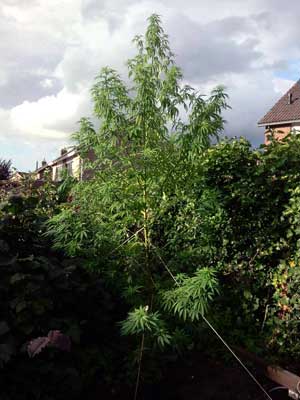
But that's very simplified, and it's a lot more complicated than just that in practice. The strain makes a huge difference, as some plants react to light differently, and may be able to support different sized colas.
But in addition to the height, the overall size/mass of the plant has a big effect on your final yields. A bigger plant can simply support more and bigger colas. Because of that, it's good to build up overall size as opposed to just height, if you want to maximize yields. And many growers let their plants get bigger horizontally, while restricting their ability to grow taller than the light can support.
Also, if you grow a very short plant with tons of colas and some defoliation, the plant will often respond by growing basically just a bush of buds, even though each individual bud isn't that long. However, if you can get a bigger plant with that same density of buds, you'll end up with bigger yields overall, just because there's more places for buds to grow.
What do other growers think?
- Likes 6
Comment
-
This should be a sticky Nebz! I do have a question but i will keep reading lol NebulaHazePerpetual setup!
- Likes 1
Comment
-
I've got a semi-strange question that probably doesn't apply to most of you: Can you fail a urinalysis from the day-to-day touching of the plants throughout their stages of growth?#TeamAutoMechanics
Previous grow journals:
Pure Power Plant and Blue Mystic + Freebies
Girl Scout Cookies and Gorilla Glue (AutoMechanics Grow Thread)
Grow Room Video: https://vimeo.com/218651917
- Likes 1
Comment
-
I would say yes it could be a problem.
"Transdermal Marijuana
Marijuana is lipophilic, which means that it can be dissolved into a fat-soluble substance and readily enter cell membranes. In other words, it can be effective when applied topically on the skin. Marijuana can be used transdermally to relieve pain from many conditions. Medical marijuana can be a balm, lotion, ointment or rubbing alcohol solution. In the old days when people only had plants to use for medication, many patients would soak marijuana leaves in alcohol and apply them as a poultice to an arthritic or swollen joint."
From....http://drsircus.com/medical-marijuan...oral-cannabis/
-
I've heard of a case where someone claimed that they failed a drug test after trimming their plants after harvest, but I didn't know them well enough to know if I could believe them. I hope other growers chime in with their own experiences!
-
I personaly passed a drug test last week after my really nice (autoflower time line)
-
As a new grower of anything the watering questions were the toughest to find answers on. I now understand why but as a newbie I was looking for general amounts of water to give. Like a solo cup full when it's in a solo cup, 1 liter when it's in a gallon pot.... *those aren't real measurements just examples.... I still don't know the answer but I'm pretty good with the 20-30% run off.
I just watered today. 3 liters produced this much runoff. Where I'm at right now
Comment
-
If you have the space and time to do it, start a bag seed and abuse it, You will get to see the symptoms and what they are capable of overcoming. I got a lot of confidence from a 'test' grow
-
I've always been a fan of experimenting on great genetics. You're going to get a harvest at the end of 4 months, and spend a lot of time and electricity, why not harvest the best buds possible? Seeds cost less than $10 a piece, and $40 for a half dozen seeds is a very small cost over the course of a grow! Bud quality can be really hard to predict with bagseed, even if the original buds were fire quality! It's because they haven't been bred to be a stabilized strain, so there's more variation between each seed, and some are good while others may be meh. That being said, some growers have gotten incredible results with bagseed! It's all part of the luck of the draw.
-
-
Comment
-
If you're talking about the sticky, honey-like substance that secretes from cannabis sometimes (http://www.growweedeasy.com/weird-or...s-can-make-sap), I know that one cause of sap in cannabis seems to be giving a lot of sugar or carbohydrate based supplements. The sap in that case is sweet but not potent. It probably also has a genetic component, or other environment factors.
But often when you cut a cannabis plant it doesn't produce that kind of sap. It sort of gets wet at the injury site, which slowly hardens into a solid knuckle. I believe that wetness is caused by nutrient and sugar filled water that are being transplanted through the plant. The actual chemical process that seals off the injury site is complicated, but basically the plant has an emergency response when it detects and injury, and starts sending things to immediately plug up the breech, and then focuses on repairing the area more generally. I found an interesting article that explains some of what we know about plant injury response, if you wanted to check it out (it does get a bit wordy with a lot of jargon)! https://www.ncbi.nlm.nih.gov/pmc/articles/PMC4165286/
To your second question: Some nutrients can be transported throughout the plant (mobile nutrients: Nitrogen, Phosphorus, Potassium, Magnesium, Molybdenum, Nickel and Chlorine) and others mostly don't move once they're set down (immobile nutrients: Calcium, Sulfur, Boron, Copper, Iron, Manganese and Zinc). When a leaf is withered, I think it's a matter of whether the vascular system (like their veins) is intact enough to transport resources back to the main plant. If an undamaged leaf is on a part of the plant that doesn't get light any more, you'll notice it'll slowly start to get deficiencies and eventually die. It's like the plant is giving up on those leaves that aren't useful any more, and taking everything it can to use for the rest of the plant. Another example of a plant "stealing" nutrients is if a plant gets a Nitrogen deficiency. The bottom leaves keep turning yellow and falling off, as the plant takes the Nitrogen and transports it to the newest growth.
-
Do I need to do anything special to clean my grow space. I just finished my first grow!!! Now I'm cleaning out the tent and wondering if I need to sanitize....
Oh yea, my grow was a resounding success thanks to GWE!! Pics to come after drying...
- Likes 1
Comment
-
Congrats on a great harvest! At least for me I clean with bleach water, though hydrogen peroxide is another good choice! I think the most important thing is pulling everything out and cleaning all the dust and stray leaves that seem to get everywhere. It's also important to clean the intake and vent holes especially if they have mesh, because they can start to get dirty like the lint trap of a dryer which prevents to fan from cooling as well Lastly, if you have glass in your hood it's good to clean the glass on both sides because some light is lost when it has to go through dusty glass
Lastly, if you have glass in your hood it's good to clean the glass on both sides because some light is lost when it has to go through dusty glass 
-
That's a great question! CRI is a measure of how similar the colors of an object appear compared to if it were under natural light. The CRI is determined by the light source's spectrum. So for example an HPS grow light has a very low CRI because everything under HPS light looks yellow or orange, and very few other colors shine through. However, under a 'daylight' colored CFL, the colors are about the same as they would be under the sun, so it has a very high CRI. You can have LEDs that put out purple-looking light, so very low CRI, or LEDs that put out white-looking light, or high CRI. It depends on the spectrum.Originally posted by Vapo69 View PostHi all......i don't know if this has been asked......apologies if it has .......so, how important to a plant is a high C.R.I*??
.......so, how important to a plant is a high C.R.I*??
*colour rendering index.
For plants, the spectrum is important; there needs to be a combination of blue, red and at least a little green light for proper plant growth. But once the basic needs are met and plant is growing green and healthy, it seem the total amount of light (total light energy being received by the plant) has a more consistent effect on increasing overall photosynthesis than further changes to the light spectrum.
CRI is really important to people because it's been developed to help us represent natural colors in artificial light and with photography. However, CRI doesn't really have a whole lot of meaning to the plant because it has its own requirements for light spectrum that are not quite the same as what's most pleasing for human eyes.
That being said, the range of light spectra that can be used by the plant (PAR range) is roughly similar to the range of light spectra we can see with our eyes, which is why you sometimes see people using "human" measurements like lumens and lux as a rough estimate to apply to plants
- Likes 3
Comment
-
Thanks NebulaHaze , that is great information,particularly for us new growers, as some might be swayed by a lights high CRI rating if it wasn't understood properly😂😂
-
One cool thing about high CRI is you can easily see your plants and leaf color, as well as take great pictures of them, so it definitely has some benefits!
-
The anatomy of cannabis. What all the parts on the plant are called and what that plants uses those parts for. like the calyx and pistols. Also terpenoids and trichs, etc. I'm just very curious as to the anatomy and make up of the plant.3rd Grow
Amnesia Haze, Bubbliciois, Super Skunk
Tent- 4x4x6.5
Light- 600w HPS/ 220w COB
Medium- KindSoil/FFOF
Pots- 3gal fabric
Nutrients- None
_____________________________
Comment
-
I have a few examples here, and let me know if you have further questions!Originally posted by Kpenn View PostThe anatomy of cannabis. What all the parts on the plant are called and what that plants uses those parts for. like the calyx and pistols. Also terpenoids and trichs, etc. I'm just very curious as to the anatomy and make up of the plant.
Here's a closeup of the base of cannabis leaves, where bud sites form.
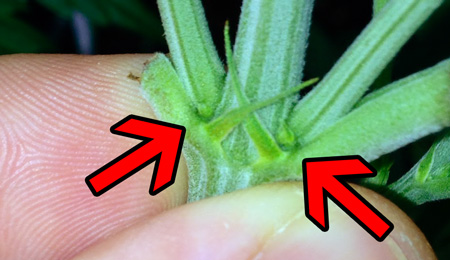
Those little bumps are preflowers. They appear on the plant when it's about 3-6 weeks old (even in the vegetative stage; earlier for males and later for females) and reveal the gender of the plant (whether it makes buds or pollen sacs). Here's a breakdown of male vs female preflowers. "Buds" are actually a bunch of female flowers stacked on top of each other!
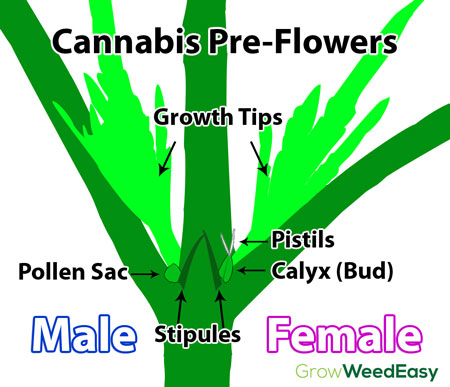
More on preflowers here!
As far as terpenoids, they have a variety of effects and many growers suspect that terpenoids actually change the effects of cannabis and may even make buds feel more potent. More here.
What about trichomes? I'm not 100% sure. I know there are different types of trichomes. If you look at plants under a microscope, you can see the mushroom shaped ones we're all familiar with, but there are also spikey, hair-like trichomes with out "heads" that are all over the leaves.
I've looked into this before and I think there's lots of debate about exactly what they're for, and it's probably a bunch of things, depending on the strain. In the wild, cannabis contains very low levels of THC, high levels of CBD, and very few trichomes. We only have high-THC buds with lots of trichomes due to selective breeding over thousands of years. It's difficult to look at modern plants, which are all hybridized from locally bred strains from around the world and bred over generations. We get a much closer picture of how they survived in the wild by studying wild hemp.
Now I want to do more research, post more pics, make more diagrams and publish a page all about the anatomy of a plant with tons of pictures. I'll tag you so you can take a look when it's done!
- Likes 2
Comment
-
hi nebula. re your comment on selective breeding over 1000s of yrs, i read recently on another forum that supposedly truly wild (or no-human-interference) grown cannabis is extinct, or is at least not known to be not extinct. do you think that's true? if so, it's kinda sad but a friend i was talking about it with says i'm just being "sentimental" and that as long as it's grown, and grown well, why does it matter if it's wild or not. any thoughts?
-
I was taught that the original Ruderalis / auto-flowering strains were actually discovered in Siberia as a type of wild hemp. It automatically starts flowering and is ready to harvest in just a few months because they only have 2-3 months of weather that stays above freezing temperatures. Once it starts getting warm it's almost a race to finish before winter comes. Here's a picture of a small female Ruderalis plant: https://cannabisgrowing.files.wordpr...comparison.jpg
In fact, cannabis has found a way to grow on every continent except Antarctica. You can find tons of "ditch weed" all over the US, especially in areas where there used to be hemp cultivation. It's an insidious weed in certain parts of the middle of the country. I guess that's not truly wild since it was descended from industrial hemp, which was cultivated by humans.
One of the things I hope we maintain, even more than wild hemp, is landrace strains. That is any strain that has been bred and developed by locals in different parts of the world. Each population breeds cannabis with different effects, and some of the best strains have come from collecting local strains from around the world and breeding them together in unique and unusual ways. I hope we save as many seeds from these types of strains as possible! I know that's a big concern in parts of Europe. When cannabis is legal in the US, I've vowed to myself to maintain a seedbank, to make sure we're saving all these genes for future generations to enjoy!
-
that's very informative. thank you!
and i *really* hope you get to maintain a seedbank....that would be so awesome.
-
I've read the article of when to harvest the plant, but my main concern is to know when to start the flushing process to time it with my ideal time for harvesting. I can't imagine there's a definite answer due to the many different factors involved, so I presume it's just a matter of experience?
- Likes 1
Comment
-
Curious if anyone has tried (and succeeded) to make feminized seeds using colloidal silver spray with autoflowers? Would you be able to make feminized auto seeds this way?Last edited by StoneyTony; 05-05-2017, 09:22 PM.Fast Buds GSC & Green Crack Auto's
Veg: 4x4x6 - 7-gal Smart Pots - Coco/Perlite - 4 300w LED's - Flora Trio + CalMag
Bloom: 4x4x6 - 7-gal Smart Pots - Coco/Perlite - 4 300w LEDs - Flora Trio + CalMag & Superbloom
“…marijuana is one of the safest, therapeutically active substances known to man.” – Judge Francis Young (DEA)
Comment

Comment